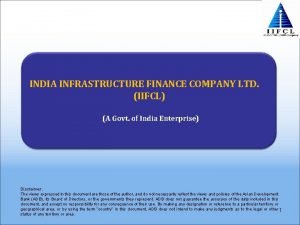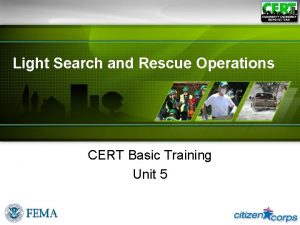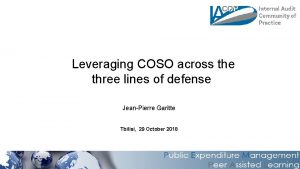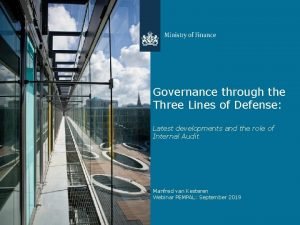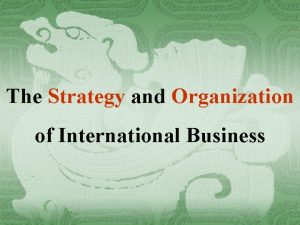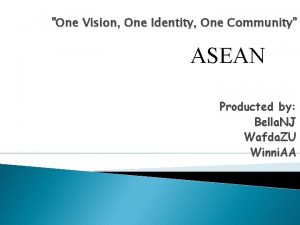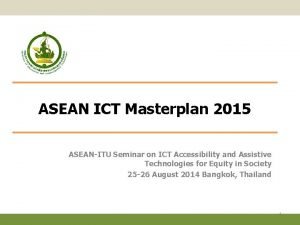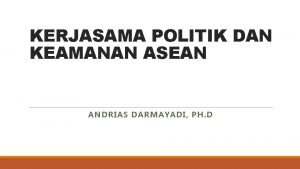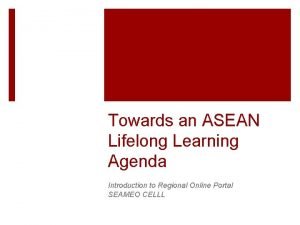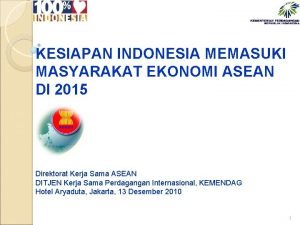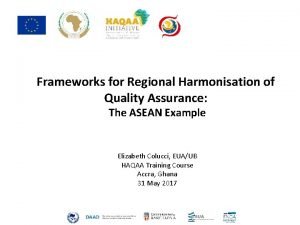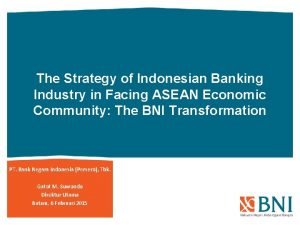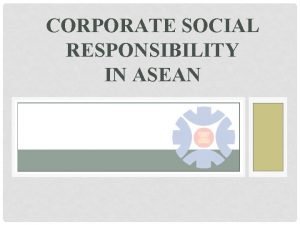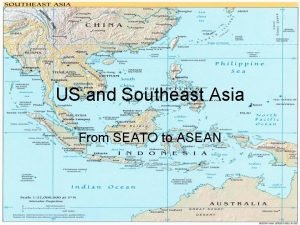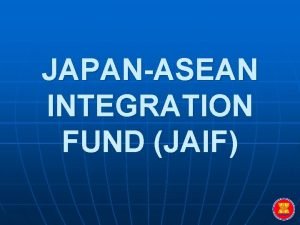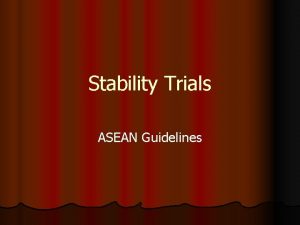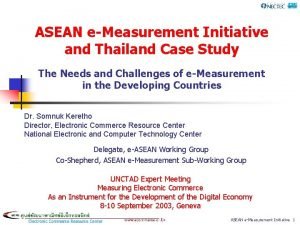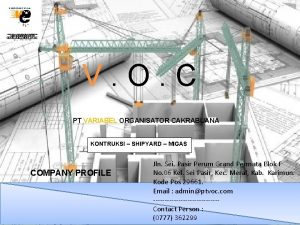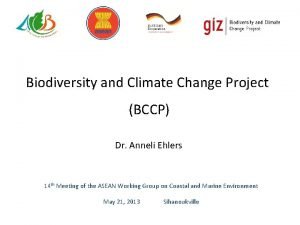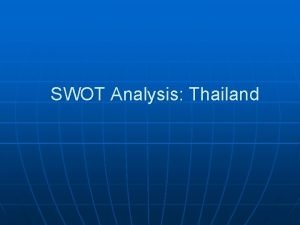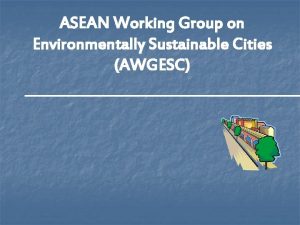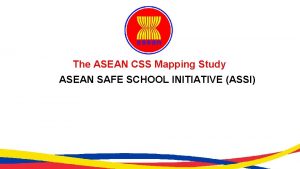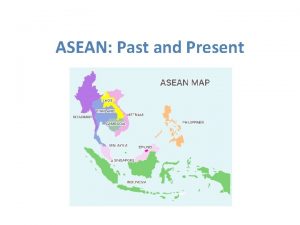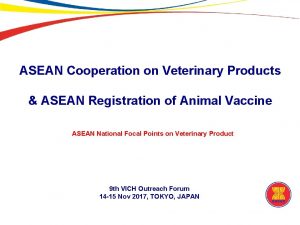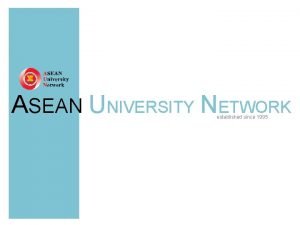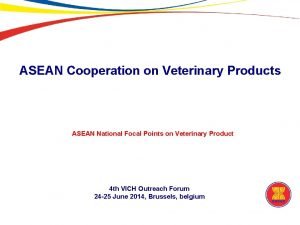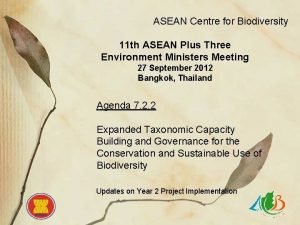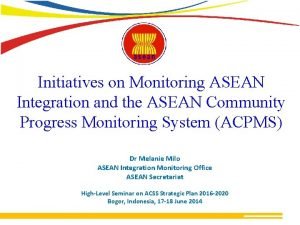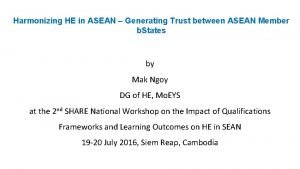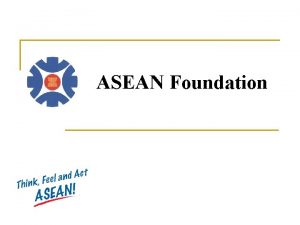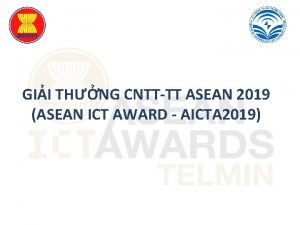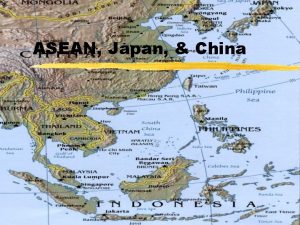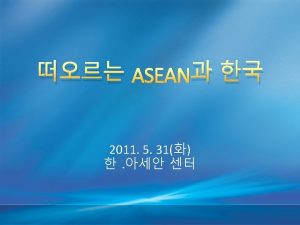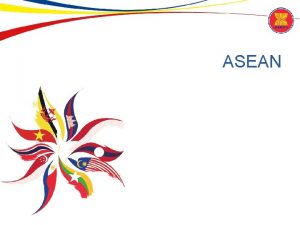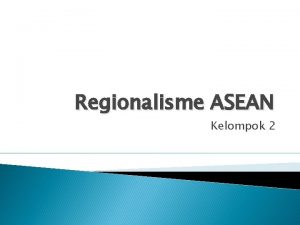Leveraging PPPs to Finance Infrastructure in the ASEAN




































- Slides: 36

Leveraging PPP’s to Finance Infrastructure in the ASEAN Region

ASEAN Region Faces Growing Infrastructure Needs & Challenges

Many Asian Mega Cities Lack Adequate Mass Transport Infrastructure 90 80 Tokyo City Rail distance per 1 M population 70 60 Seoul City Shanghai City SG MP 50 NYC 40 SG 2015 30 Hong Kong Plan Hong Kong UA SG 2005 BKK 20 Jakarta 10 Karachi Mumbai Mega. City MNL 0 0 10 20 30 40 -10 Stations per 1 M population 50 60 70

Metro Manila as an Example NCR Area (sqkm) Pop Density (Pop/sqkm) Manila 620 12 M 19, 000 85 (+45) incl PNR 1. 3 M Tokyo 620 9 M 14, 000 700 30 M Shanghai 500 10 M 20, 000 590 (+100) 8. 4 M (Metro) Seoul 605 10 M 16, 000 390 (+100) 7. 2 M (Metro) comparables Km of rail Ridership

Harnessing the Private Sector through PPPs are a tool to harness private sector capital, expertise and innovation to deliver infrastructure investment needs

What is a PPP? P_ _ _ _ _ _ _ _

What is a PPP? Preparation Process Partnership

PPP Benefits Single procurement processes Stronger incentive framework to minimize construction delays Single accountability point Investor responsible for cost overruns, delays and operating performance Investor responsible for lifecycle costs

PPP Considerations le ab t i Su y f i nt Ide jects Pro bli u P c le b a St icy Pol ent ed s a t. B u p s t Ou ndard Sta P t n e stm e v t In ities e k r Ma ortun p Op ro act ent r t n Co agem n Ma n tio ac s n Tra ts r he l Cos g i H ita Cap s ces r pa s n Tra nt al & onme g e e L Envir v i duc ional n o C itut t Ins ger n o L s Los o ol r t on f. C x& e l p tion m o C para Pre &

What Makes Bankable PPPs? IFC’s Perspective

Key PPP Components CONTRACT DESIGN PROJECT FINANCING SERVICE OBLIGATIONS/STANDARDS SUSTAINABLE RISK ALLOCATION MONITORING MECHANIMS DISPUTE RESOLUTION TENDER PROCESS INVESTOR FAIR TREATMENT GLOBAL MARKETING TRANSPARENT TENDER & EVALUATION CRITERIA SERVICE AFFORDABILITY BALANCED PAYMENT SUSTAINABLE & BANKABLE STRUCTURE

Bankability Requirements Appropriate pricing to enable adequate debt service coverage and equity returns Appropriate risk allocation and mitigation Transparent procurement Legal and regulatory certainty Long-term demand projections Macro-economic stability Country’s debt capacity Appropriate credit enhancement if necessary

Risk Allocation Principles • Risks should be borne by the party that can mitigate them Rationale: That party can bear the risks at the least cost overall lower price for the service offered • Problems at the risk allocation stage can delay project negotiations and financial closing Several examples of project negotiations 5 to 10 years • Even if projects close in exuberant market sentiment problems down the road in long-term concessions • Risks not mitigated properly are borne by the consumer higher tariffs; potential renegotiation and/or contract/service failure

Bankability Principles • Lenders’ requirements are key • Debt provides 60%-80% of project funding and typically follow a limited recourse project finance structure • Project finance lenders rely on cash flows of the project and not on sponsor’s balance sheet • Sponsors will not use their own balance sheets for large projects in emerging markets (especially over $100 m or so) and will require significant debt financing to limit equity risk

Risk Allocation and Mitigation Risk Party bearing risk Rationale / Mitigation Construction Private (occasionally both) • Fixed price turnkey EPC contract • Liquidated damages for delay and performance Financing Private • Financing bond Operating Private • Penalties, operations security, O&M contractor Demand Depends on • Single buyer electricity / water offtaker: type of project Government takes the risk • Airport concession: private sector (may include exclusivity provisions) • Toll road: risk may be shared through minimum traffic guarantees, “shadow tolling” or annuity Payment Depends on Same as above. Payment obligations of SOEs (eg type of project water and power offtakers) may need a government guarantee and PRG/MIGA/PRI cover

Risk Allocation and Mitigation Risk Party bearing risk Rationale / Mitigation Macroeconomic: inflation Built into tariff • Single buyer: tariff indexation / user charges • Airport, toll roads, distcos: indexation of regulated user charges Macroeconomic: FX rates Built into tariff • Single buyer: tariff indexation / user charges • Airport, toll roads, distcos: indexation of regulated (if FX user charges financing) FX availability Government If project revenues are in a “soft” currency, Gov covers this risk Political, regulatory Government In less mature markets, assurances from Government, Governmental Force Majeure and “change in law” provisions are common

Risk Allocation and Mitigation Risk Party bearing risk Rationale / Mitigation Natural force majeure affecting private party Private sector • Commercial insurance reinsurance • Some retention Natural force majeure affecting public party Public party • Commercial insurance • Mostly retention Project specific: Fuel supply Could be either • Borne by public party if fuel supply is statecontrolled Project specific: Hydrology Could be either or shared • If reliable long-term data exist, private sector may be willing to take the risk (priced in)

Other Contractual Provisions Issue Considerations Refinancing • Are project revenues based on contractual tariffs based on certain debt assumptions? • Long-term debt availability vs. mini-perms Lenders’ step-in rights • Required for project finance • Direct Agreement between government / offtaker, sponsors and lenders Dispute Resolution • Local vs. international • Arbitration venues Governing Law • Local vs. international Contract rebalancing • May be appropriate under certain circumstances Termination Payments • For sponsor default • For Government / SOE default or PFM events • For natural force majeure events

Example ASEAN PPP’s Manila LRT 1, Myingyan IPP & Yangon Expressway

32 -year concession to rehabilitate, extend, operate, and transfer Awarded to a local consortium of Ayala, Metro Pacific Investments with Macquarie; Metro Paris as operator 1 million passengers daily with improved access to services. $924 million in private investments. Manila: LRT 1 Extension (2014) $312 million premium paid to government.

General Facts Metro Manila: • 16 cities and 1 municipality • Population (2010 census): 25 million • Area: 640 sq. km. • Density: ca. 2, 000 per sq. km. LRT 1: • Operational since 1984 • Fully elevated 20 -km guideway • 20 stations • Average daily ridership 500, 000+ pax/day • Farebox ratio 1. 26

LRT 1 Cavite Extension PPP – Project Scope Government Counterparts • Department of Transportation – main line government agency • Light Rail Transit Authority– owner/operator of existing assets Project Scope • 32 year concession • Operations and management of the existing LRT 1 • Financing, construction, commissioning and operation of an 11 -km extension to Cavite, a province south of Metro Manila. Project Cost (Government Estimate) • Civil & Electromechanical Works for the Extension: US$925 mln (private) • Additional New Trains and ROW: US$575 million (public) • Government capital grant of up to US$112 mln (bid parameter)

LRT 1 PPP – Key Risk Allocation Risk Private Concessionaire Existing Assets condition on turnover Financing – Extension & Rehab Financing – ROW & Add Trains Demand/Ridership Design & Construction ROW Operations Public (DOTC & LRTA) Fare setting (shadow fare) Maintenance Taxes Force Majeure *Shadow Fare – the Concession Agreement included a shadow fare in the event Gov did not implement planned fare increase

Myingyan IPP Project Competitive Tender Process Created Value for Myanmar • IFC was lead transaction advisor to MOEE for the PPP • First independent power producer (IPP) project in Myanmar • 16 major international companies participated in the tender process

Background • Myanmar was facing acute power shortages and has a very low electrification ratio (about 30%) • Government opened power generation sector to private investors in 201213 • 225 MW Myingyan IPP is the first competitively tendered project in the power sector • IFC was appointed as Transaction Advisor to Go. M in 2014 to advise on project preparation and implementing a transparent and competitive tender

Key Bankability Issues • New and untested market for IPPs and PPPs in general • Creditworthiness of utility off-taker • Lack of government guarantee framework • Enforcement of international arbitral awards

Result: Competitive Bidding Process for Myingyan IPP Resulted in Large Cost Savings for Myanmar Rank Annual Difference in price Over 22 year increase in from Rank 1 term Gov payments (in US cents/k. Wh) ($ mill) Bidder A 1 Bidder B 2 0. 4650 7. 9 173 Bidder C 3 0. 4869 8. 2 182 Bidder D 4 0. 7188 12. 2 268 Bidder E 5 1. 2442 21. 1 464

Yangon Expressway Network • Network of expressways for Yangon proposed to be implemented over the coming decades • Comprised of an inner ring road (elevated), outer ring road (at grade) and radial spokes Inner Ring Outer Ring

Inner Ring Road Expressway Inner ring road is comprised of three elevated sections, likely to be built in phases: • East Wing (25 km) • East-West Wing (6 km) • West Wing (16. 5 km)

Phase 1 – Yangon Elevated Expressway • Yangon Elevated Expressway Project, sponsored by the Ministry of Construction (Mo. C), is one of the priority projects of the Union Government of Myanmar( Go. M) • Project is one component of the Yangon Urban Expressway System that is intended to provide a high-standard expressway • Phase 1 - East Wing: 25 km 4 -lane elevated expressway • Built on viaduct along existing roads • Under analysis: • Number and location of on/off ramps and toll booths • Tolling structure and technology • Financing structure

Investment Opportunity • Mo. C will be the direct counterparty in the Concession Agreement (CA) • Term of CA is expected to be 30 years • Traffic demand forecast and willingness to pay study will be conducted to determine toll revenue projection

Scope of PPP Project – Private Investor • Preparation of a Detailed Engineering Design in accordance with specifications defined in the CA • Construction of the elevated expressway including all on/off ramps • Provision of toll plazas, safety facilities and other systems • Operation and Maintenance of the Expressway as a tolled expressway.

Government Support • Mo. C is committed to conduct of a fully transparent and competitive procurement process in line with best practice • Mo. C will provide Right of Way (Ro. W) for the project • Go. M will provided a Sovereign Guarantee of Mo. C obligations under the Concession Agreement • Various forms of Government financial support will be analyzed and considered for the project

Conclusion

Conclusion • PPPs can be a tool to deliver needed investment in infrastructure & services in ASEAN region • PPP will not create a financially viable project when project is intrinsically financially unviable • Lenders typically provide up to 80% of the financing for PPPs – risk allocation and process needs to comply with their requirements • Due to lack of success of many demand-risk PPP projects in previous years, many projects are now procured on an availability basis • Proper preparation and design are keys to facilitating successful PPP projects

THANK YOU www. ifc. org/ppp John Leber Investment Officer IFC Public Private Partnerships Transaction Advisory Services Tel: +632. 465. 2721 Mob: +639. 277. 929. 554 (Manila) / +1. 240. 425. 2455 (US) E-mail: jleber@ifc. org Website: www. ifc. org/ppp © IFC 2018
 India infrastructure finance company limited subsidiaries
India infrastructure finance company limited subsidiaries Line extension vs brand extension
Line extension vs brand extension Leveraging subsidiary skills
Leveraging subsidiary skills Secondary brand associations examples
Secondary brand associations examples Louisiana leveraging educational assistance partnership
Louisiana leveraging educational assistance partnership Leveraging social media for talent acquisition
Leveraging social media for talent acquisition Light search and rescue
Light search and rescue Coso three lines of defense
Coso three lines of defense Leveraging threat intelligence
Leveraging threat intelligence Secondary brand knolledge
Secondary brand knolledge Leveraging coso across the three lines of defense
Leveraging coso across the three lines of defense There is low interdependence performance ambiguity
There is low interdependence performance ambiguity Leveraging network effects
Leveraging network effects Secondary brand associations examples
Secondary brand associations examples Analyzing and leveraging decoupled l1 caches in gpus
Analyzing and leveraging decoupled l1 caches in gpus Lambang asean berupa seikat batang padi yang menggambarkan
Lambang asean berupa seikat batang padi yang menggambarkan Asean ict masterplan 2015
Asean ict masterplan 2015 Kerjasama politik dan keamanan asean
Kerjasama politik dan keamanan asean Asean centre for biodiversity
Asean centre for biodiversity Asean secretariat
Asean secretariat Asean symbol meaning
Asean symbol meaning Asean culture
Asean culture Asean quality assurance framework
Asean quality assurance framework Asean banking integration framework
Asean banking integration framework Asean countries
Asean countries Asean socio-cultural community pillar
Asean socio-cultural community pillar Peta konsep perkembangan islam di benua asia
Peta konsep perkembangan islam di benua asia Seato and asean
Seato and asean Asean background
Asean background Asean stability guideline
Asean stability guideline Asean countries
Asean countries E-asean
E-asean Pt barra asean shipping
Pt barra asean shipping Asean centre for biodiversity
Asean centre for biodiversity Talent accelerator program
Talent accelerator program Thailand swot analysis
Thailand swot analysis Asean working group on environmentally sustainable cities
Asean working group on environmentally sustainable cities
